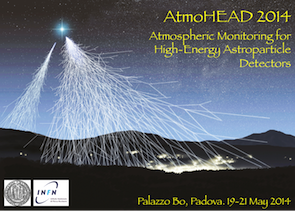Conveners
Overview of Experiments
- Aurelio Siro Tonachini (TO)
Overview of Experiments
- Karim Louedec (LPSC, CNRS/IN2P3, UJF-INPG, Grenoble)
Description
Overview of the Atmospheric Calibration system for current and planned experiments
Dr
Bianca Keilhauer
(Karlsruhe Institute of Technology KIT)
20/05/2014, 09:00
Oral
The Pierre Auger Observatory detects high-energy cosmic rays with energies above some 10^17 eV. It is built as a multi-hybrid detector measuring extensive air shower with different techniques.
For the reconstruction of extensive air showers, the atmospheric conditions at the site of the observatory have to be known quite well. This is particularly true for reconstructions based on data...
Dr
Joachim Hahn
(MPIK)
20/05/2014, 09:30
Oral
Instruments applying the IACT method, such as H.E.S.S. (High Energy Stereoscopic System), observe VHE (very high energy, E>100GeV) photons indirectly, using the Earth's atmosphere as a calorimeter. In the H.E.S.S. data reconstruction, the properties of this component are estimated by Monte Carlo simulations of a yearly averaged atmosphere density profile. Deviations of the real atmospheric...
Mr
Christian Fruck
(MPI Munich)
20/05/2014, 10:00
Oral
A method for analyzing returns of the custom-made 'micro'-LIDAR system, which is operated along side with the two MAGIC telescopes is presented. This method allows to calculate the transmission through the atmosperic boundary layer as well as thin cloud layers by applying exponential fits to regions in the signal that are dominated by Rayleigh scattering. Writing this real time transmission...
Ms
Dorothee Hildebrand
(ETH Zurich)
20/05/2014, 10:30
Oral
For Imaging Air Cherenkov Telescopes, knowledge about the condition of the atmosphere is very important. Usually, this information is gathered by external devices like lidars and pyrometers. While pyrometers only give integral information, lidars have the problem that their lasers can affect data-taking.
Based on experience from the First G-APD Cherenkov Telescope (FACT), we...
Mr
Adriano Ghedina
(TNG)
20/05/2014, 11:30
Oral
For more than 20 years the TNG and its surroundings at the ORM have been the site for monitoring
the atmosphere under several of its parameters.
From the first instruments installed in the early '90s to characterize and show the quality of the sky at the chosen site
(particularly the Automatic Weather Station and the DIMM) we evolved into the actual set up of remote sensing devices
to be...
Dr
Giuseppe Leto
(INAF-Osservatorio Astrofisico di Catania)
20/05/2014, 12:30
Oral
ASTRI, Astrofisica con Specchi a Tecnologia Replicante Italiana, is a flagship project of the Italian Ministry of Education, University and Research, entirely supported and led by the Italian National Institute of Astrophysics, INAF. The project is developed in the framework of the International Cherenkov Telescope Array, CTA. The primary goal of the ASTRI project is the realization of a wide...
Prof.
Maria Rodriguez Frias
(Space and Astroparticle Group. UAH Madrid)
20/05/2014, 17:00
Oral
An Atmospheric Monitoring System (AMS) is a mandatory and key device of a space-based mission which aims to detect Ultra-High Energy Cosmic Rays (UHECR) and Extremely-High Energy Cosmic Rays (EHECR) from Space. JEM-EUSO has a dedicated atmospheric monitoring system that plays a fundamental role in our understanding of the atmospheric conditions in the Field of View (FoV) of the telescope. Our...

